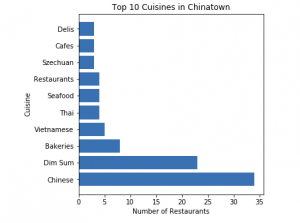1. Affordability Analysis (price range)
Yelp profiles for each food vendor and restaurant includes a price range rating (ranges from $ to $$$$) indicating the expected price to pay per person at these specific businesses. There are common trends that show that affluent neighborhoods such as Financial District and Cow Hollow/Marina consist of restaurants that are $$$ and $$$$. In FiDi and the Marina, the most reviewed restaurants are at least $$$. In lower income neighborhoods such as Bayview Hunters Point, the most reviewed restaurants contain $ to $$, indicating that people are expected to pay less per person per meal.
2. Affordability Analysis (Fast Food)

Percentage of Fast Food restaurants are most common in Bayview Hunters Point where expensive healthy and organic foods are less readily available. Fast food is cheap, affordable and accessible to BVHP residents. Marina is known for its high end restaurants where Fast Food is least favored.
3. Health Quality
San Francisco Health Department requires that each food vendor and restaurant make their health scores visible and available to the public. The food inspector seeks for different violations. Major violations can lead to closer and shut down of the facilities while minor violations can be fixed however any violation will lower the overall rating. As data supports, many restaurants in less affluent neighborhoods have a lower score such as Bayview Hunters Point and Chinatown. Higher income neighborhoods such as Cow Hollow/Marina and the Financial District have more money and demand for their business hence the higher scores to maintain the businesses.
As the time slider shows, restaurant quality in the Mission and Financial District increase over time, significantly in the Mission. This makes sense as both neighborhoods have undergone much gentrification over the past few years, and the increase in the affluence is reflected in the better quality of their food.
4. Cuisine Analysis
The following are the most frequent cuisines for every neighborhood:

The Mission has been Latino population dominated since the 1900’s. With over a century of Latino influence, culture and history, it is not a surprise that Mexican Cuisine is the most common in the Mission district. Common restaurants include Taquerias, Tapa bars and Mexican restaurants.

Chinatown, also with a dense and long history of Chinese influence since the Gold Rush in 1848, has most commonly Chinese food and Dim Sum. Chinese food includes Dim Sum restaurants, dim sum vendors, mom-and-pop shops, Cantonese and and Mandarin style foods. In addition, there are bakeries that sell popular buns and to-go items that range from $1 to $2.

The Financial District is packed with employees in the financial and technological hub of San Francisco. It is common that people go out for American food such as burgers, salads and sandwiches during lunch hours. Sandwiches are the most common as they are convenient and quick to make, similarly to Salads.

Marina has one of the highest median incomes in San Francisco. Italian is considered as upscale because of the ingredients that are included in the meal as well as the culture and manner of consumption while eating Italian. Italian restaurants have a quieter, intimate and more romantic setting and ambiance instead of noisy and casual fast food cuisines.

Bayview Hunters Point has limitations to obtaining affordable and healthy foods. As a result, many resort to cheap and fast foods such as burritos and cheap Chinese to-go boxes or simple burgers and fries. Bayview Hunters Point does not have restaurants that have romantic or intimate ambiances.